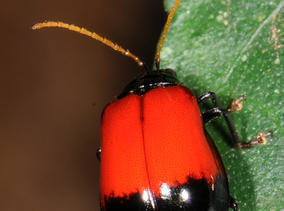You are here
Chrysomelidae Latreille, 1802
SUMMARY
Adults: Variable in habitus and size, 0.9 - 40 mm. Tarsi pseudopentamerous: 5-5-5, with fourth segment small and hidden between the lobes of the split third segment, sometimes reduced to 4-4-4 (Cassidinae); basal tarsomeres ventrally with adhesive setae. Antennae nearly always filiform or slightly serrate, rarely pectinate, clavate only in one Bornean genus (Clavicornaltica); usually 11-segmented, sometimes with only 9 (Nonarthra) or 10 segments. Head not prolongate, hypognathous. Eyes varying from small to large; no eyeless species known. Pronotum and elytra of variable shape and structure, rarely with shortened elytra (some Galerucinae). Wings usually well-developed, reduced or absent in a a few species. Pygidium exposed in some groups (Bruchinae, Cryptocephalinae). Hind femora thickened in some groups (Alticinae, Sagrinae, some Bruchinae). Abdomen with five or six ventrites.
One of the most diverse beetle families in the World, currently containing about 40'000 described species.
Subfamily classification subject to different opinions among researchers. The classification here adopted treats Clytrinae and Fulcidacinae as tribes of Cryptocephalinae. Hispinae have been shown to be paraphyletic and are here included in Cassidinae. Alticinae is here treated as a subfamily, although often reduced to a tribe of Galerucinae. Bruchinae is here treated as a subfamily, while Megalopodidae (incl. Zeugophorinae) counts as separate family. The number of subfamilies recorded from Borneo therefore stands at 11.

